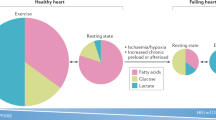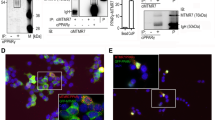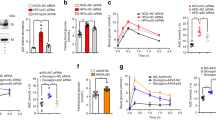Abstract
Peroxisome proliferator-activated receptor-γ (PPAR-γ) has essential roles in adipogenesis and glucose homeostasis, and is a molecular target of insulin-sensitizing drugs1,2,3. Although the ability of PPAR-γ agonists to antagonize inflammatory responses by transrepression of nuclear factor kappa B (NF-κB) target genes is linked to antidiabetic4 and antiatherogenic actions5, the mechanisms remain poorly understood. Here we report the identification of a molecular pathway by which PPAR-γ represses the transcriptional activation of inflammatory response genes in mouse macrophages. The initial step of this pathway involves ligand-dependent SUMOylation of the PPAR-γ ligand-binding domain, which targets PPAR-γ to nuclear receptor corepressor (NCoR)–histone deacetylase-3 (HDAC3) complexes on inflammatory gene promoters. This in turn prevents recruitment of the ubiquitylation/19S proteosome machinery that normally mediates the signal-dependent removal of corepressor complexes required for gene activation. As a result, NCoR complexes are not cleared from the promoter and target genes are maintained in a repressed state. This mechanism provides an explanation for how an agonist-bound nuclear receptor can be converted from an activator of transcription to a promoter-specific repressor of NF-κB target genes that regulate immunity and homeostasis.
This is a preview of subscription content, access via your institution
Access options
Subscribe to this journal
Receive 51 print issues and online access
$199.00 per year
only $3.90 per issue
Buy this article
- Purchase on Springer Link
- Instant access to full article PDF
Prices may be subject to local taxes which are calculated during checkout




Similar content being viewed by others
References
Lehmann, J. M. et al. An antidiabetic thiazolidinedione is a high affinity ligand for peroxisome proliferator-activated receptor γ (PPARγ). J. Biol. Chem. 270, 12953–12956 (1995)
Spiegelman, B. M. PPARγ: adipogenic regulator and thiazolidinedione receptor. Diabetes 47, 507–514 (1998)
Willson, T. M., Lambert, M. H. & Kliewer, S. A. Peroxisome proliferator-activated receptor γ and metabolic disease. Annu. Rev. Biochem. 70, 341–367 (2001)
Haffner, S. M. et al. Effect of rosiglitazone treatment on nontraditional markers of cardiovascular disease in patients with type 2 diabetes mellitus. Circulation 106, 679–684 (2002)
Li, A. et al. Peroxisome proliferator-activated receptor γ ligands inhibit development of atherosclerosis in LDL receptor-deficient mice. J. CIin. Invest. 106, 523–531 (2000)
Chen, J. D. & Evans, R. M. A transcriptional co-repressor that interacts with nuclear hormone receptors. Nature 377, 454–457 (1995)
Horlein, A. J. et al. Ligand-independent repression by the thyroid hormone receptor mediated by a nuclear receptor co-repressor. Nature 377, 397–404 (1995)
Glass, C. K. & Rosenfeld, M. G. The coregulator exchange in transcriptional functions of nuclear receptors. Genes Dev. 14, 121–141 (2000)
Guenther, M., Lane, W., Fischle, W., Verdin, E. & Lazar, M. A Core SMRT corepressor complex containing HDAC3 and TBL1, a WD40-repeat protein linked to deafness. Genes Dev. 14, 1048–1057 (2000)
Li, J. et al. Both corepressor proteins SMRT and N-CoR exist in large protein complexes containing HDAC3. EMBO J. 19, 4342–4350 (2000)
Zhang, J., Kalkum, M., Chait, B. T. & Roeder, R. G. The N-CoR-HDAC3 nuclear receptor corepressor complex inhibits the JNK pathway through the integral subunit GPS2. Mol. Cell 9, 611–623 (2002)
Yoon, H. G. et al. Purification and functional characterization of the human N-CoR complex: the roles of HDAC3, TBL1 and TBLR1. EMBO J. 22, 1336–1346 (2003)
Perissi, V., Aggarwal, A., Glass, C. K., Rose, D. W. & Rosenfeld, M. G. A corepressor/coactivator exchange complex required for transcriptional activation by nuclear receptors and other regulated transcription factors. Cell 116, 511–526 (2004)
Ogawa, S. et al. A nuclear receptor corepressor transcriptional checkpoint controlling activator protein 1-dependent gene networks required for macrophage activation. Proc. Natl Acad. Sci. USA 101, 14461–14466 (2004)
Hoberg, J. E., Yeung, F. & Mayo, M. W. SMRT derepression by the IκB kinase α: A prerequisite to NF-κB transcription and survival. Mol. Cell 16, 245–255 (2004)
Lowenstein, C. J. et al. Macrophage nitric oxide synthase gene: two upstream regions mediate induction by interferon γ and lipopolysaccharide. Proc. Natl Acad. Sci. USA 90, 9730–9734 (1993)
Ricote, M., Li, A. C., Willson, T. M., Kelly, C. J. & Glass, C. K. The peroxisome proliferator-activated receptor-γ is a negative regulator of macrophage activation. Nature 391, 79–82 (1998)
Oberfield, J. L. et al. A peroxisome proliferator-activated receptor γ ligand inhibits adipocyte differentiation. Proc. Natl Acad. Sci. USA 96, 6102–6106 (1999)
Tontonoz, P., Nagy, L., Alvarez, J. G. A., Thomazy, V. A. & Evans, R. M. PPARγ promotes monocyte/macrophage differentiation and uptake of oxidized LDL. Cell 93, 241–252 (1998)
Li, M., Pascual, G. & Glass, C. Peroxisome proliferator-activated receptor γ-dependent repression of the inducible nitric oxide synthase gene. Mol. Cell. Biol. 20, 4699–4707 (2000)
Liu, B. et al. Inhibition of Stat1-mediated gene activation by PIAS1. Proc. Natl Acad. Sci. USA 95, 10626–10631 (1998)
Jackson, P. K. A new RING for SUMO: wrestling transcriptional responses into nuclear bodies with PIAS family E3 SUMO ligases. Genes Dev. 15, 3053–3058 (2001)
Tallec, L. P. et al. Protein inhibitor of activated signal transducer and activator of transcription 1 interacts with the N-terminal domain of mineralocorticoid receptor and represses its transcriptional activity: implication of small ubiquitin-related modifier 1 modification. Mol. Endocrinol. 17, 2529–2542 (2003)
Janne, O. A. et al. Androgen-receptor-interacting nuclear proteins. Biochem. Soc. Trans. 28, 401–405 (2000)
Tan, J. et al. Protein inhibitor of activated STAT-1 (signal transducer and activator of transcription-1) is a nuclear receptor coregulator expressed in human testis. Mol. Endocrinol. 14, 14–26 (2000)
Kotaja, N., Karvonen, U., Janne, O. A. & Palvimo, J. J. PIAS proteins modulate transcription factors by functioning as SUMO-1 ligases. Mol. Cell. Biol. 22, 5222–5234 (2002)
Ling, Y. et al. Modification of de novo DNA methyltransferase 3a (Dnmt3a) by SUMO-1 modulates its interaction with histone deacetylases (HDACs) and its capacity to repress transcription. Nucleic Acids Res. 32, 598–610 (2004)
Nishida, T. & Yasuda, H. PIAS1 and PIASxα function as SUMO-E3 ligases toward androgen receptor and repress androgen receptor-dependent transcription. J. Biol. Chem. 277, 41311–41317 (2002)
Ohshima, T., Koga, H. & Shimotohno, K. Transcriptional activity of peroxisome proliferator-activated receptor γ Is modulated by SUMO-1 modification. J. Biol. Chem. 279, 29551–29557 (2004)
Muller, S., Hoege, C., Pyrowolakis, G. & Jentsch, S. SUMO, ubiquitin's mysterious cousin. Nature Rev. Mol. Cell Biol. 2, 202–210 (2001)
Acknowledgements
We thank A. Beas, W. Books and J. Goode for assistance with the yeast two-hybrid screen, and J. Collier for assistance with the mammalian two-hybrid assays. We thank F. Almazan for RAW264.7 cells. We thank M. Ricote for helpful discussions and M. Lambert for assistance with analysis of PPAR-γ crystal structures. We thank A. Howarth for assistance with preparation of the manuscript. These studies were supported by an American Heart Association Predoctoral Fellowship to G.P. and National Institutes of Health grants to D.W.R., M.G.R. and C.K.G, and support from the Stanford Donald W. Reynolds Cardiovascular Center to C.K.G. M.G.R. is supported by the Howard Hughes Medical Institute. Author Contributions G.P., A.L.F., S.O., A.G., A.C.L. and D.W.R. performed experimental work and data analysis. T.M.W., M.G.R. and C.K.G. performed data analysis. C.K.G. was responsible for project planning.
Author information
Authors and Affiliations
Corresponding author
Ethics declarations
Competing interests
T.M.W. is an employee of GlaxoSmithKline.
Supplementary information
Supplementary Figure S1
Efficacy of siRNAs directed against NCoR, HDAC3, HDAC7, PIAS1 and Ubc9. (PDF 112 kb)
Supplementary Figure S2
NCoR and HDAC3 are required for PPARγ-mediated transrepression. (PDF 115 kb)
Supplementary Figure S3
PPARγ transrepression does not require sequence specific DNA binding and can be extended to other LPS-dependent promoters. (PDF 163 kb)
Supplementary Figure S4
PIAS1 interacts with PPARγ and is required for ligand-dependent inhibition of iNOS gene activation. Supplementary Figure S4 was replaced on 03 February 2006. This figure replaces the erroneous posting of Figure 4 from the main text as Supplementary Figure 4. (PDF 534 kb)
Supplementary Figure S5
Sumoylation is required for PPARγ transrepression and enhances ligand dependent association with NCoR. (PDF 132 kb)
Supplementary Figure Legends
Text to accompany the above Supplementary Figures. (DOC 23 kb)
Rights and permissions
About this article
Cite this article
Pascual, G., Fong, A., Ogawa, S. et al. A SUMOylation-dependent pathway mediates transrepression of inflammatory response genes by PPAR-γ. Nature 437, 759–763 (2005). https://doi.org/10.1038/nature03988
Received:
Accepted:
Published:
Issue Date:
DOI: https://doi.org/10.1038/nature03988
This article is cited by
-
Mechanisms and functions of SUMOylation in health and disease: a review focusing on immune cells
Journal of Biomedical Science (2024)
-
The urothelial gene regulatory network: understanding biology to improve bladder cancer management
Oncogene (2024)
-
The emerging roles of SUMOylation in pulmonary diseases
Molecular Medicine (2023)
-
Transcriptomics Based Network Analyses and Molecular Docking Highlighted Potentially Therapeutic Biomarkers for Colon Cancer
Biochemical Genetics (2023)
-
Insights on the role of anti-inflammatory and immunosuppressive agents in the amelioration of diabetes
Diabetology International (2023)
Comments
By submitting a comment you agree to abide by our Terms and Community Guidelines. If you find something abusive or that does not comply with our terms or guidelines please flag it as inappropriate.



